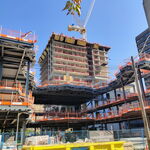duty free
Active Member
You don't need a full St. Clair style ROW to have transit priority. In fact, you don't need any ROW at all - just have a transponder trigger the traffic light as the vehicle approaches the intersection, and then load/offload at the far side of the intersection. The King transit mall is already optimized for such a concept.
You also don't need a ROW to have transit only lanes. One lane for transit, one lane for traffic, no parking, as many cities in Europe do.
no you definitely need ROWs + signal priority + turning restrictions to optimize the tram/streetcar network if that's the goal.
like you described, one lane for transit, one lane for traffic, no parking. that exact design exists on Queen's Quay, you don't need to cite Europe as an example when one exists here in Toronto just a few hundred metres south. QQ has an additional 7 m. to work with, but I think something like this could still work on Dundas, Queen, King etc...




